ERP: Effective Refractory Potential
APD: Action Potential Duration
Anti-arrhythmic medications have a variety of different actions and mechanisms, and the Vaughan-Williams classification groups them accordingly.
When this table was initially devised, there were far less anti-arrhythmic medications in comparison to the number available now and our understanding of pharmaceutical mechanisms is, although still incomplete, far greater currently.
The class system is shaky when considering class I and III drugs, given that lots of the drugs in these classifications have similar mechanisms, ergo, could easily fit in the other class category. Even so, whilst the Vaughan-Williams system has limitations, it is still the one through which most physicians base their treatment strategies.
The medications, and their grouping denote the differing efficacies for particular arrhythmias.

The below table shows the usage of the pharmaceuticals in the Vaughan-Williams classifications, as well as some that it does not feature.



